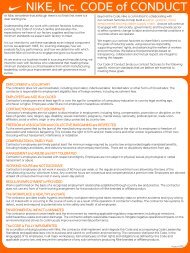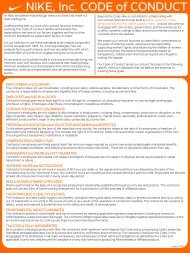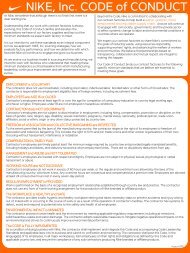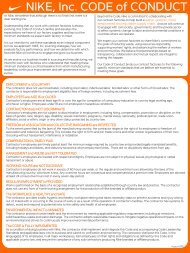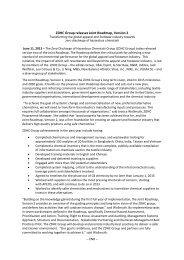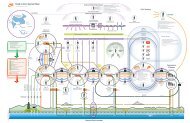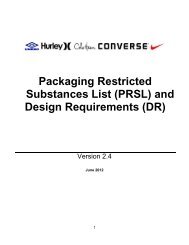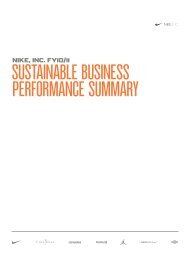COC CLS - Healthy Safety Environment - NIKE, Inc. - The Journey
COC CLS - Healthy Safety Environment - NIKE, Inc. - The Journey
COC CLS - Healthy Safety Environment - NIKE, Inc. - The Journey
You also want an ePaper? Increase the reach of your titles
YUMPU automatically turns print PDFs into web optimized ePapers that Google loves.
HAZARDOUS MATERIALS<br />
STANDARD<br />
<strong>The</strong> contractor must protect human health and the environment by meeting applicable regulatory<br />
requirements including air emissions, solid/hazardous waste and water discharge. <strong>The</strong> contractor<br />
adopts reasonable measures to mitigate negative operational impacts on the environment and strives<br />
to continuously improve environmental performance.<br />
‣ Develop and implement processes and procedures for hazardous material storage,<br />
transportation and use. <strong>The</strong> aim of these processes and procedures is to minimize risks to human<br />
health and the environment.<br />
RESPONSIBILITIES<br />
Location Manager must ensure that hazardous material procedures are developed, implemented and<br />
followed.<br />
HSE Representative must establish, maintain and administer hazardous substance processes and<br />
procedures.<br />
Managers and Supervisors must ensure that employees are trained and adhere to the requirements of<br />
the hazardous material processes and procedures.<br />
Employees must adhere to the requirements of the hazardous materials processes and procedures.<br />
DEFINITIONS<br />
• Hazardous material is any substance or material, which presents a risk to health, safety, environment,<br />
and property when used, stored or transported. <strong>The</strong> term includes hazardous materials and<br />
hazardous wastes.<br />
REQUIREMENTS<br />
1. RISK ASSESSMENT—Each facility must have a documented annual risk assessment performed which<br />
includes as a minimum:<br />
a. A survey to identify all potentially hazardous materials.<br />
b. Level, type (e.g. inhalation, skin contact, ingestion etc.) and duration of exposure.<br />
c. Amount of substance used and location.<br />
d. Preventative measures to be taken (e.g. ventilation, personal protective equipment,<br />
emergency showers or eye wash stations).<br />
2. POLICIES & PROCEDURES—Each facility must implement procedures to reduce or eliminate the risk<br />
associated with hazardous materials which must cover as a minimum, the following:<br />
a. Material safety data sheets (MSDS) must be available for all hazardous materials. No hazardous<br />
material shall be allowed on site without a material safety data sheet. <strong>The</strong> MSDS must be<br />
available in all areas where hazardous materials are used and stored.<br />
b. All hazardous materials must be stored in suitable containers and labeled with the hazard<br />
information. <strong>The</strong> containers must be:<br />
<strong>Environment</strong> <strong>CLS</strong> – Page 1 04.14.10



